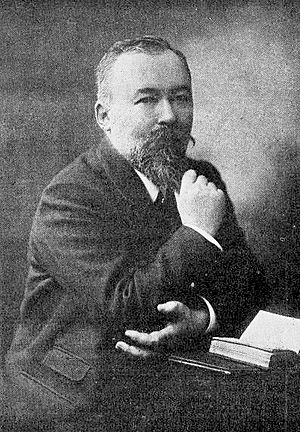Julien Tiersot facts for kids
Julien Tiersot was a French music expert, composer, and a pioneer in studying music from different cultures. He was born on July 5, 1857, in Bourg-en-Bresse, France, and passed away on August 10, 1936, in Paris. He is remembered for his important work in understanding music from around the world.
Contents
Discovering World Music
Julien Tiersot was very interested in French popular music. In 1889, he wrote a book called History of the Popular Song in France. He tried to show how popular songs were connected to classical music.
That same year, during the 1889 Paris Exhibition, he saw Javanese gamelan music and dances. This experience opened his eyes to the value of music from outside Europe. He realized that these traditions were just as developed as Western classical music.
Exploring Music Cultures
After this, Tiersot became interested in music from many different places. He studied music from Japan, China, Java, India, Central Asia, the Arab region, and Armenia. He also looked at music from Native American and African-American cultures.
He called this new field "Musical Ethnography." Today, we call it ethnomusicology. This is the study of music from different cultures around the world. Tiersot was one of the first people to explore this area.
Challenging Old Ideas
Tiersot's research sometimes caused disagreements. His findings often went against old ideas about which cultures' music was more important. He asked, "Does not the music of people separated by space, have the same value as that of people separated by time?" This showed his belief that all music traditions are valuable.
His work looked at music not just as art, but also how it fit into society.
Collecting French Songs
From 1895 to 1900, Tiersot collected many popular songs from the French Alps. He gathered about 450 songs and even found different versions of them. In total, he collected more than 1,200 musical scores.
In 1903, he published a book called Popular Songs Collected in the French Alps. This book included 227 of these melodies.
Other Musical Interests
Tiersot was also curious about many famous classical composers. He studied the works of Couperin, Bach, Berlioz, and Smetana.
In 1888, he sang a part in the first performance of a piece by the composer Chabrier. Later, in 1917, another composer named Arthur Honegger used some Native American themes that Tiersot had found in his notes for a symphonic poem.
Julien Tiersot was also the president of the French association of musicologists, the Société française de musicologie, from 1920 to 1923 and again in 1927.
Selected Publications
- Histoire de la chanson populaire en France, 1889
- Promenades musicales à l'exposition, Les danses javanaises, 1889
- Chants populaires pour les écoles, poèmes de Maurice Bouchor, 1897
- Chansons populaires recueillies dans les Alpes françaises, 1903 Texte en ligne
- Hector Berlioz et la société de son temps, 1904
- Notes d'ethnographie musicale, 1905–1910
- La Musique dans la comédie de Molière, 1921
- Les Couperin, 1926
- Smetana, 1926
- Musique aux temps romantiques, 1930
- La Chanson populaire et les écrivains romantiques, 1934
- J. S. Bach, 1934
- Lettres françaises de Richard Wagner, 1935
- Mélodies populaires des Provinces de France ( without date )
See also
 In Spanish: Julien Tiersot para niños
In Spanish: Julien Tiersot para niños
- Ethnomusicology


